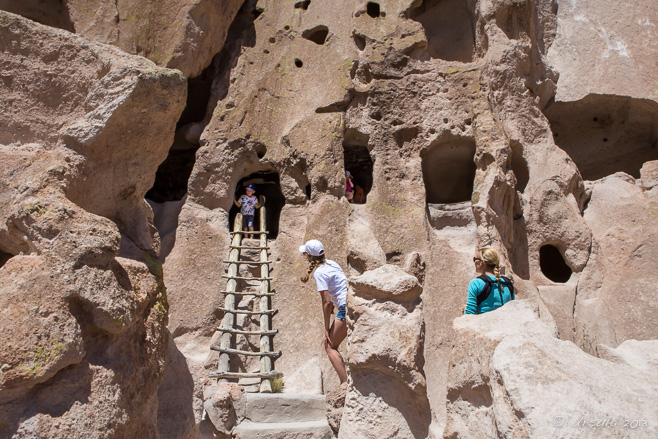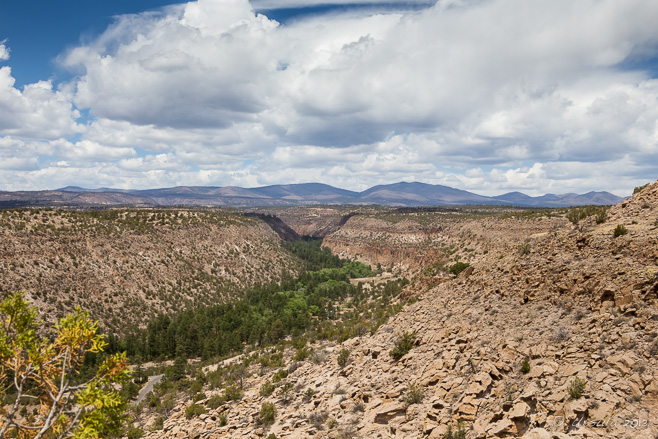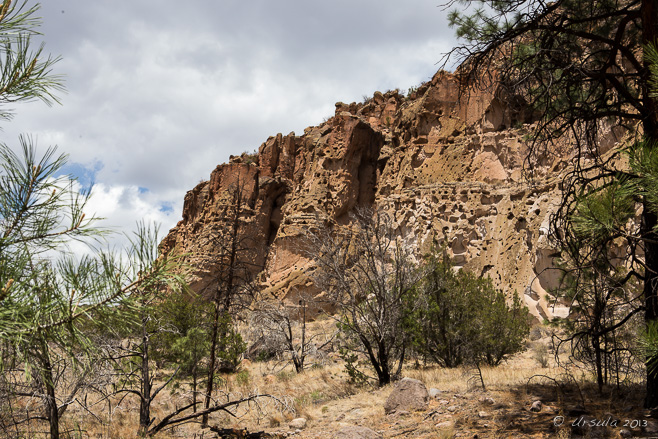
Cliff Dwelling
Visitors to the Frijoles Canyon in Bandelier National Monument, New Mexico, explore the cavates: cliff rooms that were dug out of volcanic tuff some time during the Ancestral Pueblo Period.
. . .
There is something intriguing about walking in the footsteps of prehistoric people – people who have left no written records and whose lives we can only pretend to reconstruct from the buildings and artefacts they left behind.
I had read about the Cliff Palace, a complex of cliff dwellings built by the ancient Anasazi – more properly called the Ancestral Pueblo People (APP) – in what is now the Mesa Verde National Park in Colorado. I had been hoping to visit the complex on our last driving trip across the United States, but the site was too far off the route we needed to follow. Fortunately for us, archaeological remains and monuments can be found all across Utah, Colorado, Arizona and New Mexico.
Bandelier National Monument is just an hours’ drive out of Santa Fe, which made it accessible to us. Managed by the US National Parks Service, the 33,000 acre reserve protects the remains of an ancestral settlement that was occupied between 1150 and 1550 CE. The park was named for a self-taught anthropologist and historian: Adolph FA Badelier, who was introduced to the settlement in the Frijoles Canyon in 1880, and whose pioneering work helped establish the foundation for southwestern archeology.
Native American Pueblo people say that their ancestors have always lived in the arid “Four Corners” region of the Southwestern United States. Modern archeologists, however, think that nomadic hunter-gatherers migrated into the region some 10,000 years ago.
Wherever they originated, sometime before 1200 CE, the Ancestral Pueblo People built their homes into the canyon walls and floor. They began to practice agriculture up on the Pajarito Plateau and in Frijoles Canyon, cultivating corn, beans, and squash. They domesticated turkeys for food and feathers, and dogs to help hunt and for companionship. Like their hunter-gatherer fore bearers, they hunted deer, rabbit, and squirrel, and supplemented their diet with native plants.

New Mexico Vista
The landscape around Santa Fe is typical of the area: dry mesa and green river canyons.

Sides of the Frijoles Canyon
The geology here in the Pajarito Plateau is the result of two massive eruptions of the Jemez Volcano, fourteen miles to the northwest, over a million years ago. The pink walls of the canyon are not sandstone, but compacted volcanic ash.

Mule Deer Hiding
We walked along the Nature Trail, which follows the Frijoles Creek, through a forest that hides animals …

American Robin (Turdus migratorius) in a Gambel Oak Tree (Quercus gambelii)
… and bird life.

Ponderosa Pine (Pinus ponderosa) Bark

Look Up!
The Ancestral Pueblo people used the wood from the tall, straight, ponderosa pine trees as roof beams for their homes.

The Ladder
Soon we come to the first …

Up the Ladder
… of four wooden ladders …

On the Ladder
… that lead 140 feet (42.7 metres) up the canyon wall to Alcove House, a circular ceremonial chamber or kiva. Access to the most interesting part of the site was fenced off when we were there, but at least we had the view over the canyon before heading back down the way we had come.

Park Worker
Back on solid ground, we crossed paths with workers mending damage from the most recent floods. Frijoles Creek, which flows all year, is subject to flash-flooding regularly. “In August 2011 [..a] flash flood (over 7,000 cubic feet/second) destroyed the trail near Lower Falls.”

Frijole Canyon Floor
Once we are away from the creek, the landscape changers dramatically.

Cane Cholla (Cylindropuntia Imbricata)
Although considered “famine food” in modern times, it is thought that the Ancestral Pueblo People (APP) made good use of the yellowish-green fruit of the Walking Stick cactus. It could be eaten fresh or dried for winter.

Pictograph
This painted design (now covered in perspex for protection) would have been part of a back wall. The viga holes in the cliff-face, which once held rafters, give an indication of how wide and high this multi-story long-house was.

Walkway
The evidence of housing stretches along the south-facing wall of the canyon, where occupants would have benefited from the afternoon sun, especially in winter.

Back Walls
In addition to the painted designs and the viga holes, we can see niches and carved patterns and drawings, which probably held some special significance.

Textured Walls
Tuff, the compacted volcanic ash, has a gritty texture and is easily eroded by wind and rain..

Erosion

Cave Kiva
Traditionally, a kiva is a room used by Puebloans for religious rituals. This one is reconstructed based on the assumption that it was used for sacred weaving.

Through the Canyon
Navigating the narrow pathways can be as challenging as climbing the steep ladders.

Cliff House
Families explore nooks and crannies in the “cavates”, or cave rooms.

Tyuonyi
The stone outlines of the village Tyuonyi can be seen on the Frijoles Canyon floor. Tyuonyi, probably built around 1380 C.E., was home to about a hundred people until the area was abandoned about 1550.

Rock Sculpture ~ Volcanic Tuff

Talus Houses
These buildings were reconstructed in 1920 to give visitors an idea of how cliff houses may have looked. However, it is now thought that entry would have most likely been through doorways in the roof, not in the walls.

Through the Housing
At the side of the path, you can see the stone walls that once formed part of the oval plaza of Tyuonyi. The circular city-complex was three stories high in some places.

American Kestrel (Falco Sparverius)
Back at the Visitor Center, we meet a rehabilitating kestrel.

Feathered Head Gourd Mask
In the giftshop, modern renditions of traditional art forms bring the past into the present.
The Pueblo people stopped living at this site over 450 years ago – and no one is quite sure why. But, from the beginning of the 1500s, they moved away from the Pajarito Plateau – many think they migrated to the expanding economies along the Rio Grande – and left the the Frijoles Canyon empty…
… empty – except for the Ancestral spirits who are still thought to reside there.
“Movement is life. Movement is seen everywhere… Movement was characteristic of our ancestors, who moved across the landscape like the clouds across the sky.”
 — Tessy Naranjo, Santa Clara Pueblo
— Tessy Naranjo, Santa Clara Pueblo
Pictures: 20May2013































.png)


This brings back good memories of our travels.
[…] states that are home to numerous ruins of cliff dwellings – ancient homes of the Ancestral Pueblo People. (iPhone […]
[…] Utah, Colorado, Arizona and New Mexico. Our visit to this small museum prompted our later visit to Bandelier National Monument further south in New […]